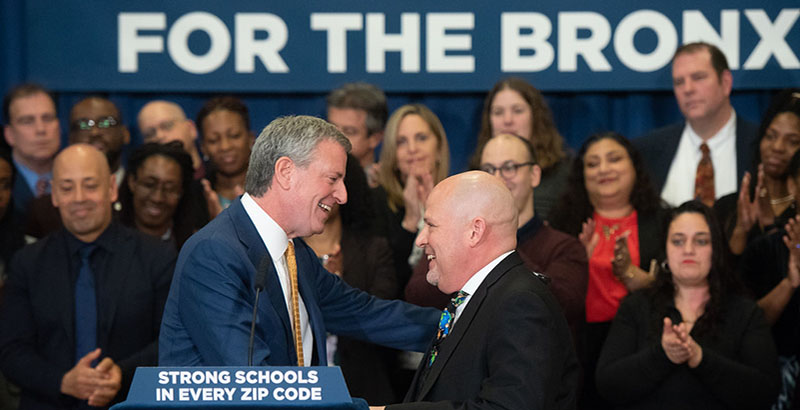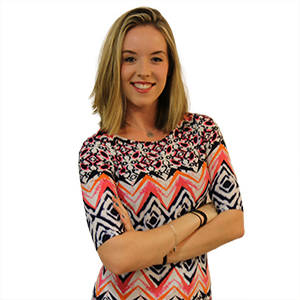UFT President Michael Mulgrew on Making Sure Imagine NYC Schools Delivers, the Role Teachers Will Play and Whether the $32M Effort Will Define de Blasio’s Last 2 Years

As New York City embarks on the first major schools expansion of Mayor Bill de Blasio’s six-year tenure, the district is relying on teachers as allies.
“Teachers are essential to this initiative,” the city’s Department of Education told The 74, referring to the Imagine NYC Schools undertaking announced last month to open 20 new district schools and revamp another 20 across the five boroughs starting in fall 2021.
Adopting an untried approach for New York City, the DOE invited educators, along with students, parents and the broader community, to submit innovative design ideas for these future schools as part of a citywide competition. Ideas can be “outside the box,” officials say — schools could cater to the needs of certain student populations or neighborhoods, specialize in particular subject areas or adopt nontraditional methods of instruction, for example.
In another marked shift politically and philosophically, the de Blasio administration is partnering with XQ, Laurene Powell Jobs’s endeavor to promote high school innovation nationwide, and Robin Hood, a long-standing, Wall Street-backed anti-poverty foundation, to help fund the $32 million initiative. Both outside partners are aligned with education reform.
While the teachers union is historically wary of private money and influence in education — it opposed the opening of dozens of small schools funded by outside donors under former mayor Michael Bloomberg’s administration and has railed against charter schools — teachers are excited by this new collaboration, UFT President Michael Mulgrew told The 74 last month.
For teachers, this is “basically like, ‘Oh, wow, they’re asking us [what we want to see in schools]. This is kind of nice,’” Mulgrew said, adding, “Teachers are pretty much tired of the top-down.”
Educators have turned out in droves to district-led information sessions to learn more about the design process, with dozens on one occasion braving a Wednesday downpour in mid-October to attend a session in the Bronx. The first deadline to submit a “statement of intent” is Tuesday, Nov. 12 — just six weeks after Imagine NYC Schools was announced. The DOE will continue to accept applications in future rounds.
The 74 spoke with Mulgrew about making sure Imagine NYC Schools delivers on its promises, the role teachers will play and whether this will define de Blasio’s education agenda in his last two years in office. Answers have been lightly edited for brevity and clarity.
The 74: What makes this different for you [when it comes to private money in education]?
Mulgrew: First, I want to be clear — we don’t appreciate when people come in and try to tell us what we have to do. [That’s different] if we’re going to work with them in partnership and they’re putting money in place. … When I started speaking with the Department of Education over last spring, they said, ‘Look, would you be supportive if we went out and worked with private partnerships?’ … They said they wanted to engage the stakeholders. I said if you want to do that, we will work with you hand-in-hand in partnership. Because if we talk to a community ahead of time and really get them excited and engaged about this school that they’re getting, that school has a much better chance of being successful right off the bat.
But let’s be clear — there’s no strings attached.
What were some of the main concerns, if any, that UFT initially brought to the table?
The concerns were really more about how do we actually do this process of engaging the community, and how do we help them create a vision for the things that they might come up with. … Right now, we’re thinking [design teams] might be playing with [ideas about] schedules, or specific approaches to instruction, as well as specific subjects that they want to emphasize. You might want a school that’s completely about project-based learning and all hands-on instruction. That’s a whole different school than building just a traditional school. We just have to be able to meet the needs of what the community is asking us to do.
What do you see as the role of teachers and the union in this competition to create new schools and redefine existing ones?
Two different ways. For a “reimagine” school … that would be a group of teachers working with a group of parents. For a new sited school, it gives teachers an opportunity to go to a community and say, “Look, this is what I would love to do in terms of, [as an example], project-based learning,” and explain to parents what that means. Then that teacher could work with a group of other teachers and actually start the birthing of a school.
When that comes together, that’s really exciting, because then you have parents and teachers working on a unique vision.
So you’re saying teachers, along with parents, should really be leading this.
Yes. … For decades, New York City would build a school and tell the community, ‘Here’s a school and this is what it’s doing.’ … We’ve switched it this time. We want you to tell us what you want in your school. Do you want a school with humanities? Do you want a medical tech school with information technology? Do you want a school that’s based off of children working in group instruction the majority of the day?
Part of this has to be giving people some ideas and options [though]. Because especially if you’re not a teacher, you might not know. And even if you are a teacher, you might not know about the different ways and different ideas that people have out there that —when implemented properly — have proven to be successful.
If we’re imagining it’s fall 2021 already, these schools are opening — what constitutes a success in UFT’s eyes?
Well, it takes two to three years to see where a school is moving. To me, first and foremost, it’s how much involvement does it have with the parents. It’s attendance. I would do a deeper dive to make sure that the instructional practice and the curriculum that we said had to be in place is in place, and that the professional development is completely aligned. You put those things in place and make sure they’re in place for a couple of years — then I’m 99.9 percent sure that school is going to be highly successful.
Does UFT see its role as holding the district accountable for making sure that the vision currently matches the end reality?
Once there is an agreed-upon vision and it has been accepted in a plan design, yes. I would hope that there’s not too much that we have to do, because I believe that [the DOE] really wants to do this work with complete fidelity. But if there’s a problem, of course we would look at that, and we would go deal with it. But I think the majority of our role will actually be to help the teachers and everyone through this process and support the work.
Do you think this undertaking should be the mayor’s education focus for the last two years of his term? Or are there other more pressing problems?
Look, this is 20 new schools being sited and the possibility of 20 schools doing a reimagine. That’s 40 schools total. This is just a side piece on his education [agenda]. This is important — this is a new way for New York City to do it; it’s never done it this way before — so I think this is something that is really worthwhile and meets his agenda. But on the other hand, completing 3-K for the entire city is probably the biggest challenge they have over the last two years.
Get stories like these delivered straight to your inbox. Sign up for The 74 Newsletter

;)
